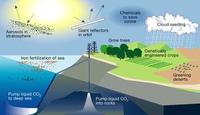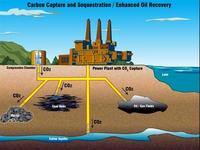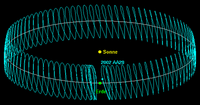-
2013 natural catastrophes dominated by extreme weather in Europe, Supertyphoon Haiyan

Exceptionally high losses from weather-related catastrophes in Europe and Supertyphoon Haiyan dominated the overall picture of natural catastrophes in 2013. Floods and hailstorms caused double-digit billion-dollar losses in central Europe, and in the Philippines one of the strongest cyclones in history, Supertyphoon Haiyan, resulted in a human catastrophe with over 6,000 fatalities.
-
-
“Power to gas”: Synthetic natural gas from excess electricity
“Power to gas” is a key concept when it comes to storing alternative energy. This process converts short-term excess electricity from photovoltaic systems and wind turbines into hydrogen. Combined with the greenhouse gas CO2, renewable hydrogen can be used to produce methane, which can be stored and distributed in the natural gas network. Researchers have now succeeded in further optimizing this process.
-
-
Nations' nuclear ambitions not discouraged by few suppliers
Twenty-nine countries are considering constructing their first nuclear power plant. There are doubts as to which of these nuclear “newcomer” countries can actually succeed and join the thirty-one countries that already operate nuclear reactors. If even half of the national plans for nuclear power plants materialize, the geography of nuclear energy would radically change and could revitalize a stagnant industry. But given the obstacles to starting a national nuclear power program even for rich and stable countries, it’s not likely to happen quickly elsewhere.
-
-
Abandoned mine offers clues about permanent CO2 sequestration
Power plants and other industries are responsible for more than 60 percent of global CO2 emissions, according to the International Energy Agency. Sequestering the CO2 in magnesite deposits would prevent the gas from entering the atmosphere and warming the planet. Stanford University researchers, studyingveins of pure magnesium carbonate, or magnesite — a chalky mineral made of carbon dioxide (CO2) and magnesium – in an abandoned mine in the Red Mountain, propose a novel technique for converting CO2 into solid magnesite, making CO2 sequestration feasible.
-
-
NIST invites comment on RFP to support cybersecurity center of excellence
The National Cybersecurity Center of Excellence (NCCoE) is inviting comments on a Partial Draft Request for Proposals (RFP) for a contractor to operate a Federally Funded Research and Development Center (FFRDC) to support the mission of the NCCoE. The FFRDC will be the first solely dedicated to enhancing the security of the nation’s information systems.
-
-
Minimizing power grid disruptions from wind power
Researchers have found that an increase in the use of wind power generation can make the power grid more fragile and susceptible to disruptions. The researchers, however, did not just identify the problem — they have also devised a technique for coordinating wind power generation and energy storage in order to minimize the potential for such power disruptions.
-
-
Relying on geoengineering to reduce climate change unlikely to succeed

Reducing the amount of sunlight reaching the planet’s surface by geoengineering may not undo climate change after all. Researchers used a simple energy balance analysis to explain how the Earth’s water cycle responds differently to heating by sunlight than it does to warming due to a stronger atmospheric greenhouse effect. Further, they show that this difference implies that reflecting sunlight to reduce temperatures may have unwanted effects on the Earth’s rainfall patterns.
-
-
Urgent action needed to save the Great Plains water supply
Significant portions of the Ogallala Aquifer, one of the largest bodies of water in the United States, are at risk of drying up if it continues to be drained at its current rate.The body of water, also known as the High Plains Aquifer, spans from Texas to South Dakota and drives much of the region’s economy. Scientists are proposing alternatives that will halt and hopefully reverse the unsustainable use of water drawdown in the aquifer.
-
-
Carbon capture technology vital for meeting climate targets

In 2010, coal, oil, and gas supplied more than 80 percent of the world’s total primary energy supply — and the demand for energy is projected to increase by two to three times by 2100. Studies show that without policies to cut greenhouse gas emissions, fossil fuels will remain the major energy source in 2100, with resulting increases in greenhouse gas emissions. Where should policymakers focus their carbon mitigation efforts, however? Which technologies hold the most promise?Scientists say that a combination of carbon capture and storage (CCS) and bioenergy has advantages over solar, wind, and nuclear because it can lead to negative emissions. Moreover, bioenergy can be converted into liquid and gaseous fuels which are easily storable and can be readily used by current transportation systems,thus taking some pressure off other sector in terms of required mitigation effort.
-
-
World's shrinking groundwater sources in urgent need of better governance

Groundwater makes up 97 per cent of the world’s available fresh water. Total global use is estimated by scientists at around 1,000 cubic kilometers a year, with the largest users being India, China, and the United States. Since 1900, the world has drawn down its groundwater reserves by an estimated 4,500 cubic kilometers — and demand continues to increase, especially in arid countries, which are rapidly running short of water that can be affordably extracted. Scientist has urged the world to take better care of its groundwater resources — or risk dangerous scarcities, economic impacts, and potential conflicts in coming decades.
-
-
NASA going asteroid hunting

The NASA Asteroid Robotic Retrieval Mission concept involves the capture of an asteroid, and dragging it onto a new trajectory that traps it in the Earth–Moon system where it will be further investigated by astronauts. The current mission design requires the target asteroid to have a diameter of seven to ten meters.
-
-
How effective are renewable energy subsidies? It depends
Renewable energy subsidies have led to explosive growth in wind power installations across the United States, especially in the Midwest and Texas. Electricity produced by wind is emission free, so the development of wind-power may reduce aggregate pollution by offsetting production from fossil fuel generated electricity production. Emission rates of fossil fuel generators, however, vary greatly by generator (coal-fired, natural gas, nuclear, hydropower). Thus, the quantity of emissions offset by wind power will depend crucially on which generators reduce their output. In other words, the quantity of pollutants offset by wind power depends crucially on which generators reduce production when wind power comes online.
-
-
Scientists predicted size, location of 2012 Costa Rica earthquake
The Nicoya Peninsula in Costa Rica is one of the few places where land sits atop the portion of a subduction zone where the Earth’s greatest earthquakes take place. Costa Rica’s location therefore makes it the perfect spot for learning how large earthquakes rupture. Because earthquakes greater than about magnitude 7.5 have occurred in this region roughly every fifty years, with the previous event striking in 1950, scientists have been preparing for this earthquake through a number of geophysical studies. The most recent study used GPS to map out the area along the fault storing energy for release in a large earthquake. The study accurately forecasted the size and location of the magnitude 7.6 Nicoya earthquake that occurred in 2012 in Costa Rica.
-
-
Curbing climate change requires more attention to livestock
While climate change negotiators struggle to agree on ways to reduce carbon dioxide (CO2) emissions, they have paid inadequate attention to other greenhouse gases associated with livestock. Researchers say that cutting releases of methane and nitrous oxide, two gases that pound-for-pound trap more heat than does CO2, should be considered alongside the challenge of reducing fossil fuel use. Ruminant livestock (cattle, sheep, goats, and buffalo) produce copious amounts of methane in their digestive systems. CO2 is the most abundant greenhouse gas, but the international community could achieve a more rapid reduction in the causes of global warming by lowering methane emissions through a reduction in the number of ruminants, the researchers say, than by cutting CO2 alone.
-
-
Natural gas saves water, reduces drought vulnerability
A new study finds that in Texas, the U.S. state that annually generates the most electricity, the transition from coal to natural gas for electricity generation is saving water and making the state less vulnerable to drought. Even though exploration for natural gas through hydraulic fracturing requires significant water consumption in Texas, the new consumption is easily offset by the overall water efficiencies of shifting electricity generation from coal to natural gas. The researchers estimate that water saved by shifting a power plant from coal to natural gas is 25 to 50 times as great as the amount of water used in hydraulic fracturing to extract the natural gas.
-
More headlines
The long view
Helping Strengthen America’s Critical Infrastructure
Everyday life depends on a robust infrastructure network that provides access to running water, communications technology and electricity, among other basic necessities. The experts who keep our national infrastructure secure and resilient also need a strong network to share their knowledge and train the next generation of professionals capable of solving complex infrastructure challenges.
AI and the Future of the U.S. Electric Grid
Despite its age, the U.S. electric grid remains one of the great workhorses of modern life. Whether it can maintain that performance over the next few years may determine how well the U.S. competes in an AI-driven world.
Using Liquid Air for Grid-Scale Energy Storage
New research finds liquid air energy storage could be the lowest-cost option for ensuring a continuous power supply on a future grid dominated by carbon-free but intermittent sources of electricity.
Enhanced Geothermal Systems: A Promising Source of Round-the-Clock Energy
With its capacity to provide 24/7 power, many are warming up to the prospect of geothermal energy. Scientists are currently working to advance human-made reservoirs in Earth’s deep subsurface to stimulate the activity that exists within natural geothermal systems.
Experts Discuss Geothermal Potential
Geothermal energy harnesses the heat from within Earth—the term comes from the Greek words geo (earth) and therme (heat). It is an energy source that has the potential to power all our energy needs for billions of years.
